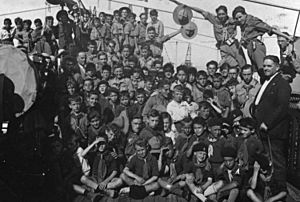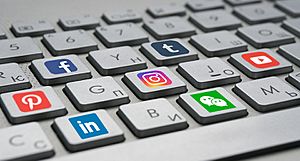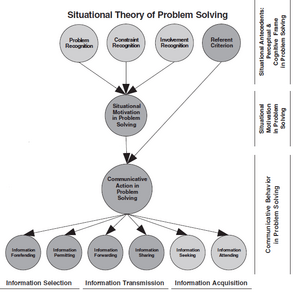Public facts for kids
In communication science and public relations, "public" mostly means people. The meaning of this is different than other ideas, such as gatherings in social life to talk about people (public sphere). The meaning of this is also talked about in the learning of government (political science), the learning of how humans think (psychology), and the learning of giving things to people (marketing). This word's meaning is very hard to make, as people think that public has different meanings.
Contents
How the word is created
The word "public" comes from the Latin publicus, or "of the people".
Types of "public"
Social publics
Social publics are people who like the same ideas or hobbies.
Networked publics
Networked publics are social publics who are organized by the new technology. Because of this, networked publics are the result of technologies that connect people (networked technologies, like social media), and the whole result from a combination of the people in the networked public, their technologies, and their ideas.
Publics and problems
The situational theory of publics, is about the idea that publics can be used and organized by how much they know (are aware of) their common problem, and how much action the group has taken to resolve that problem. This theory shows when people communicate ideas and when the ideas are about the people who are important in solving the common problem. This theory is almost the same as John Dewey's theory of publics and Blumer's theory of publics.
Key concepts
The five key concepts in this theory are:
- how much the people know that have a problem (problem recognition)
- how much the people know their actions are limited (constraint recognition)
- amount of how much a problem affects someone (level of involvement)
- amount of new info gotten (information seeking)
- amount of new info processed (information processing)
History
This theory comes from James E. Grunig's writing, "The Role of Information in Economic Decision Making" in 1966. This writing was the beginning of the situational theory of publics, as it had the first key idea, problem recognition, in the writing. Then, when he wrote about the decisions of people who own land in Columbia to become a professor, he also wrote about the second key idea, constraint recognition. He then added Herbert Krugman's idea of the third key idea, level of involvement, to explain the difference between the fourth and fifth key ideas, information seeking and information processing. After that, he wrote a book in 1984 which was named "Managing Public Relations", which further made the situational theory of publics make more sense, based on John Dewey's book, which was named "The Public and Its Problems".
Development
People who use the theory created equations which used the theory to organize the different types of publics, and the most real effects of communication for each public. Because these math rules were created, it made the theory more understandable and became used in a more common way in learning the theory (academic studies) and in some professional learning. This theory is like the learning of the actions of people buy things (consumer behavior), health communication, how media works (media exposure), and the communication of government related ideas (political communication), which are common in other parts of the learning of communication (communication research). But, this theory has more common key ideas and a more developed system of learning and analysis because of the equations. Because of this, it can become more common (popular) and include other smaller less common theories inside it (subsume).
Extension
Even though the theory is well developed, it develops even more common. The theory has been used to show why people join groups who really want things to happen (activist groups), to organize the external (real, actual) and internal (perceived) parts (dimensions) of problem recognition, and to learn whether information that is used in information processing (processed information) can create publics. Also, some more research was done on the internal and external dimensions of problem recognition, constraint recognition, and level of involvement (Grunig & Hon, 1988; Grunig, 1997). The research is about whether the ideas are internal or external. The research shows that if the concepts are internal, they can be changed by communication, and that if they are external, then the holdable things that are around the person need to be changed in order for the person's concept of the variables to change (Grunig, 1997, p. 25). But, there is a small amount of research on the internal and external dimensions of the three key concepts, so there can be more studies on these concepts (Grunig, 1997). Then, in 2011, Jeong-Nam Kim and Grunig extended the theory to the situational theory of problem solving.
- Hannay, Alastair (2005) On the Public Routledge ISBN: 0-415-32792-X
- Kierkegaard, Søren (2002) A Literary Review; Alastair Hannay (trans.) London: Penguin ISBN: 0-14-044801-2
- Lippmann, Walter. The Phantom Public (Library of Conservative Thought), Transaction Publishers; Reprint edition, January 1, 1993, ISBN: 1-56000-677-3.
- Mayhew, Leon H. The New Public: Professional Communication and the Means of Social Influence, (Cambridge Cultural Social Studies), Cambridge University Press, September 28, 1997, ISBN: 0-521-48493-6.
- Sennett, Richard. The Fall of Public Man W. W. Norton & Company; Reissue edition, June 1992, ISBN: 0-393-30879-0.
Images for kids






